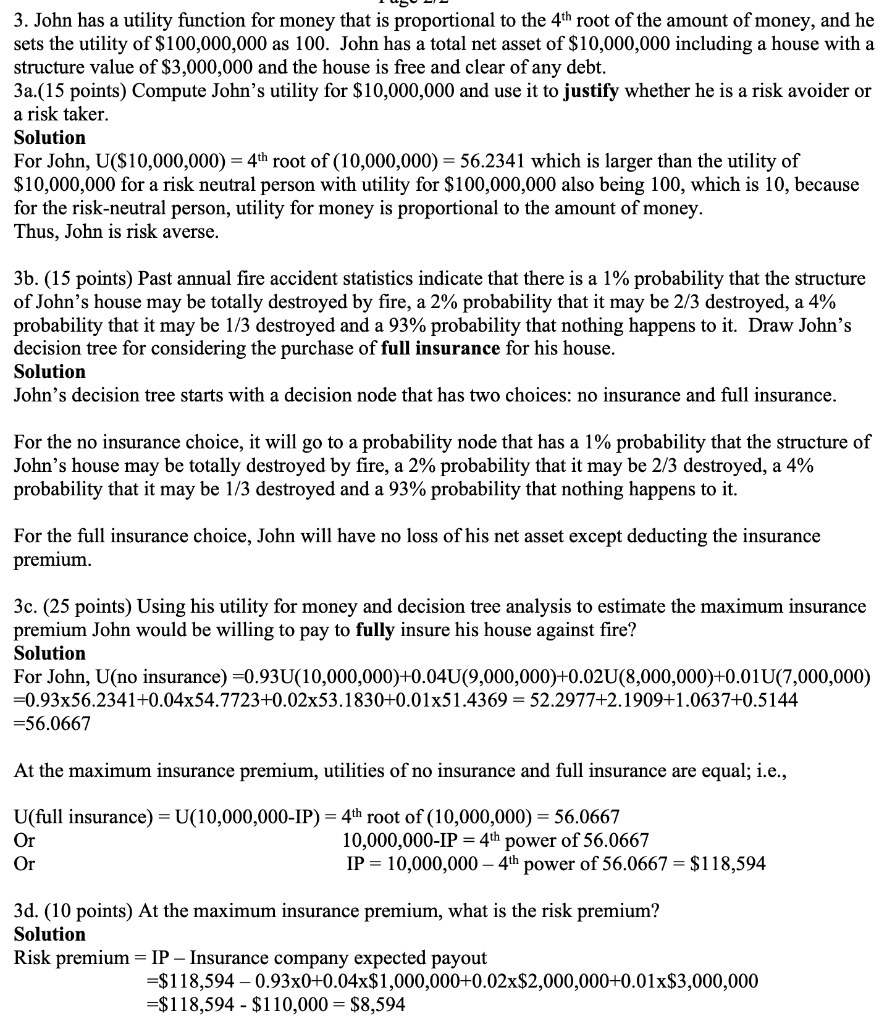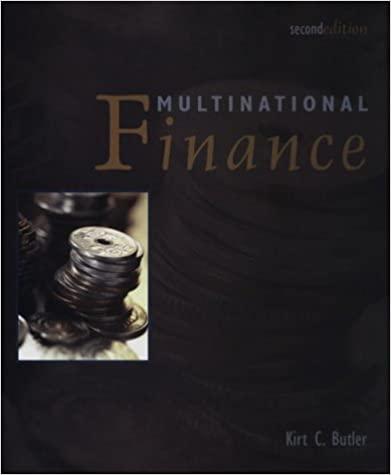I have some of the question and answer, but could you please show how to complete the problem? Please show detailed work to help me better understand the problem. Thank you!

15U 3. John has a utility function for money that is proportional to the 4th root of the amount of money, and he sets the utility of $100,000,000 as 100. John has a total net asset of $10,000,000 including a house with a structure value of $3,000,000 and the house is free and clear of any debt. 3a.(15 points) Compute John's utility for $10,000,000 and use it to justify whether he is a risk avoider or a risk taker. Solution For John, U($10,000,000) = 4th root of (10,000,000) = 56.2341 which is larger than the utility of $10,000,000 for a risk neutral person with utility for $100,000,000 also being 100, which is 10, because for the risk-neutral person, utility for money is proportional to the amount of money. Thus, John is risk averse. 3b. (15 points) Past annual fire accident statistics indicate that there is a 1% probability that the structure of John's house may be totally destroyed by fire, a 2% probability that it may be 2/3 destroyed, a 4% probability that it may be 1/3 destroyed and a 93% probability that nothing happens to it. Draw John's decision tree for considering the purchase of full insurance for his house. Solution John's decision tree starts with a decision node that has two choices: no insurance and full insurance. For the no insurance choice, it will go to a probability node that has a 1% probability that the structure of John's house may be totally destroyed by fire, a 2% probability that it may be 2/3 destroyed, a 4% probability that it may be 1/3 destroyed and a 93% probability that nothing happens to it. For the full insurance choice, John will have no loss of his net asset except deducting the insurance premium. 3c. (25 points) Using his utility for money and decision tree analysis to estimate the maximum insurance premium John would be willing to pay to fully insure his house against fire? Solution For John, U(no insurance) =0.93U(10,000,000)+0.04U(9,000,000)+0.02U(8,000,000)+0.01U(7,000,000) =0.93x56.2341+0.04x54.7723+0.02x53.1830+0.01x51.4369 = 52.2977+2.1909+1.0637+0.5144 =56.0667 At the maximum insurance premium, utilities of no insurance and full insurance are equal; i.e., U(full insurance) = U(10,000,000-IP) = 4th root of (10,000,000) = 56.0667 10,000,000-IP = 4th power of 56.0667 Or IP = 10,000,000 - 4th power of 56.0667 = $118,594 Or 3d. (10 points) At the maximum insurance premium, what is the risk premium? Solution Risk premium = IP - Insurance company expected payout =$118,594 -0.93x0+0.04x$1,000,000+0.02x$2,000,000+0.01x$3,000,000 =$118,594 - $110,000 = $8,594 15U 3. John has a utility function for money that is proportional to the 4th root of the amount of money, and he sets the utility of $100,000,000 as 100. John has a total net asset of $10,000,000 including a house with a structure value of $3,000,000 and the house is free and clear of any debt. 3a.(15 points) Compute John's utility for $10,000,000 and use it to justify whether he is a risk avoider or a risk taker. Solution For John, U($10,000,000) = 4th root of (10,000,000) = 56.2341 which is larger than the utility of $10,000,000 for a risk neutral person with utility for $100,000,000 also being 100, which is 10, because for the risk-neutral person, utility for money is proportional to the amount of money. Thus, John is risk averse. 3b. (15 points) Past annual fire accident statistics indicate that there is a 1% probability that the structure of John's house may be totally destroyed by fire, a 2% probability that it may be 2/3 destroyed, a 4% probability that it may be 1/3 destroyed and a 93% probability that nothing happens to it. Draw John's decision tree for considering the purchase of full insurance for his house. Solution John's decision tree starts with a decision node that has two choices: no insurance and full insurance. For the no insurance choice, it will go to a probability node that has a 1% probability that the structure of John's house may be totally destroyed by fire, a 2% probability that it may be 2/3 destroyed, a 4% probability that it may be 1/3 destroyed and a 93% probability that nothing happens to it. For the full insurance choice, John will have no loss of his net asset except deducting the insurance premium. 3c. (25 points) Using his utility for money and decision tree analysis to estimate the maximum insurance premium John would be willing to pay to fully insure his house against fire? Solution For John, U(no insurance) =0.93U(10,000,000)+0.04U(9,000,000)+0.02U(8,000,000)+0.01U(7,000,000) =0.93x56.2341+0.04x54.7723+0.02x53.1830+0.01x51.4369 = 52.2977+2.1909+1.0637+0.5144 =56.0667 At the maximum insurance premium, utilities of no insurance and full insurance are equal; i.e., U(full insurance) = U(10,000,000-IP) = 4th root of (10,000,000) = 56.0667 10,000,000-IP = 4th power of 56.0667 Or IP = 10,000,000 - 4th power of 56.0667 = $118,594 Or 3d. (10 points) At the maximum insurance premium, what is the risk premium? Solution Risk premium = IP - Insurance company expected payout =$118,594 -0.93x0+0.04x$1,000,000+0.02x$2,000,000+0.01x$3,000,000 =$118,594 - $110,000 = $8,594







